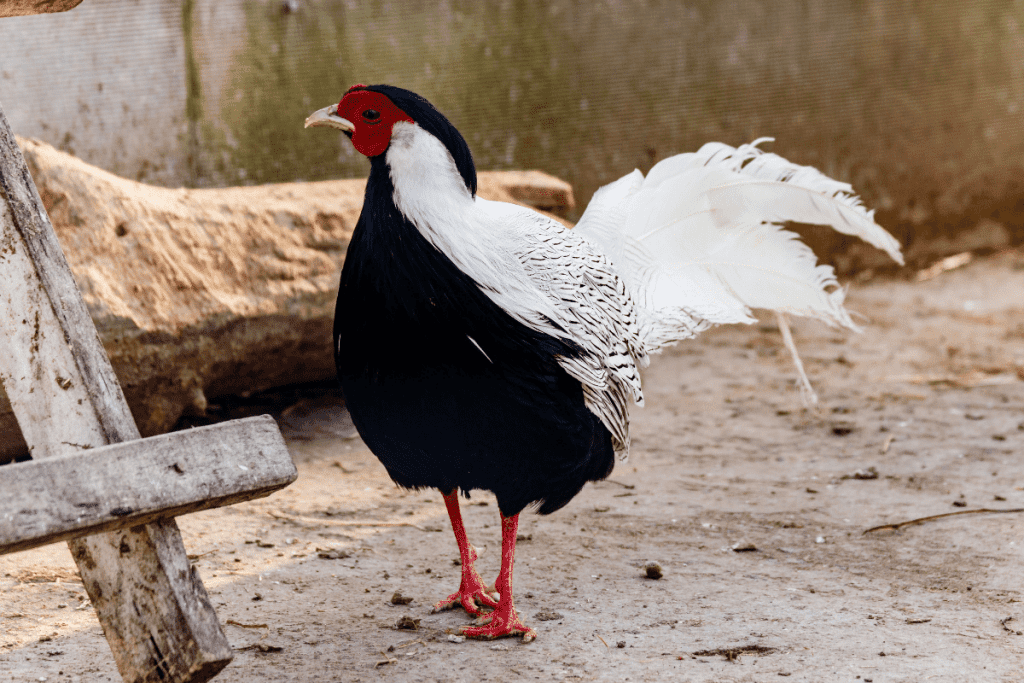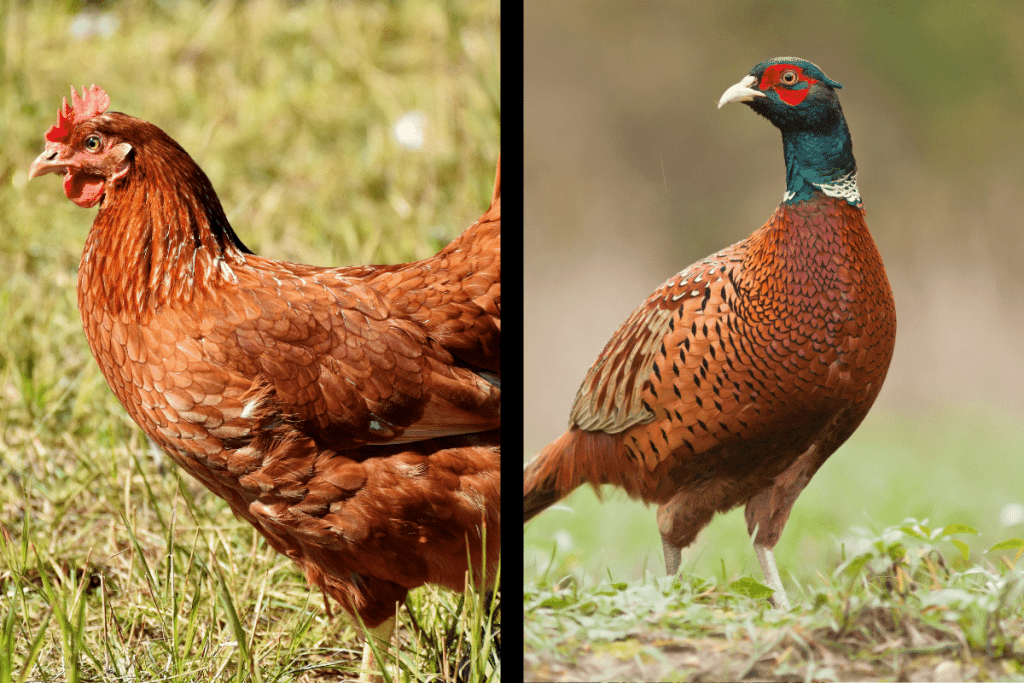Pheasants and chickens both make valuable additions to farms and homesteads.
They are attractive animals, great egg-layers, and excellent food sources.
So what happens if you cross these two birds to create a hybrid super-fowl?
Due to their genetic similarities, it is technically possible for pheasants and chickens to mate and produce hybrid offspring. The hybrid has characteristics of both parents and can occur naturally or through artificial insemination.
However, the hybrid offspring will be sterile, not producing eggs or reproducing.
Continue reading to learn about the characteristics of pheasant-chicken hybrids and some of the key factors to consider when hybridizing these birds.

Table of Contents
ToggleGenetic Compatibility Of Chickens And Pheasants
Approximately 10% of all bird species in the world are known to cross-breed with birds of other species.
The birds must be in the same taxonomic family for this hybridization to occur.
Bird species in the same family have enough shared genetic traits to reproduce, even if not in the same genus.
In the case of chickens and pheasants, both are members of the Phasianidae family.
Some examples of pheasants who produce hybrids with chickens (Gallus gallus) include the Ring-necked (Phasianus colchicus), Golden (Chrysolophus pictus), and Lady Amherst (Chrysolophus amherstiae) pheasants.
Hybridization in the Wild
Several instances of natural hybridization (without human intervention) between chickens and pheasants have been documented in scientific research articles.
One factor which comes into play to determine whether or not different species will naturally hybridize is ecological isolation.
Members of different genera are sometimes isolated due to their preferred habitat and diet differences.
Since pheasants and chickens have a very broad distribution, there is a higher probability of these two types of birds interbreeding.
Hybridization by Human Intervention
Many scientific research experiments have been conducted on hybrids of pheasants and chickens.
For these studies, hybridization is achieved using artificial insemination techniques and incubators with carefully controlled conditions and automatic turning methods.
Since both types of birds are domesticated, pheasants and chickens may also hybridize in a farm or homestead environment if they live close to one another.
However, consider several precautions when allowing pheasants and chickens to live in the same enclosure or general area.
Some of the risks involved include behavioral issues and violence between the two types of birds, the spread of disease from one species to another, and disruption of the social hierarchy of the flock.
Mortality Rate
In this study on pheasant hybridization, researchers found: out of over 1,400 eggs, only 3.5% of these eggs exhibited some development after being incubated.
Among these eggs, only about 6% hatched successfully.
As this data indicates, the success rate of cross-breeding chickens and pheasants is quite low, and in the rare case breeding produces a fertile egg, the hatchability of the hybrid eggs is also very low.
The current scientific studies on this topic were conducted on a relatively large scale.
These studies also used artificial insemination to obtain hybrid eggs.
Therefore, the probability of a pheasant and chicken successfully breeding in a farm or homesteading environment is likely even smaller than these studies suggest.
Incubation Time For Chicken-Pheasant Hybrid Eggs
Hybrid pheasant-chickens inside chicken eggs take approximately 23-24 days to hatch.
Hybrid pheasant-chickens inside pheasant eggs take about 22-23 days to hatch.
Pheasant-Chicken Pairing
Pheasant-chicken breeding is 15% more likely to produce a fertile hybrid egg when a male chicken is bred with a female pheasant than the opposite pairing.
However, the hatchability is higher when crossing a male pheasant with a female chicken.
This apparent higher fertility when using a male chicken/female pheasant combination may be due to the relatively lower volume of semen produced by male pheasants than chickens.
What Do Pheasant-Chicken Hybrids Look Like?

The hybrid birds will have physical characteristics of both species represented in their appearance, resulting in an entirely new look.
Their phenotype (physical, genetic expression) tends to include the following qualities:
- Roughly the average weight of the parent pheasant and chicken
- No wattle, comb, or earlobe
- A bare patch of skin behind the nostrils
- Intermediate tail feather length between a chicken and a pheasant
- No spurs or partially undeveloped spurs on one leg only
- Varying feather coloration depending on the parentage
The chicken parent’s feather coloration predominantly influences the color of the hybrid’s feathers.
Crossing a pheasant and chicken produces unique traits appealing to many raising birds.
However, the appearance of the hybrids is one factor among many others to consider when deciding to cross-breed these species.
Behavior of Hybrids
These hybrid birds have been known to be largely silent.
A study on bird hybrids found they sometimes produce a low chirp, but they do not exhibit the typical crow or gobble of a rooster.
Their distress call is more similar to a male pheasant.
The hybrid birds will take dust baths to keep their feathers clean and waterproof like chickens and pheasants.
Sterility of Hybrid Offspring
Unfortunately, all pheasant-chicken hybrid offspring are sterile.
This is similar to when horses and donkeys are crossed to produce sterile mules.
As members of different genera, pheasants and chickens are simply too genetically different.
The hybrid females also do not lay eggs, and the gonads of the male hybrids are underdeveloped.
No sexual activity is observed at all in the pheasant-chicken hybrids.
Why You Should Or Shouldn’t Cross-Breed Pheasants And Chickens
Due to the high mortality rate of pheasant-chicken hybrids and the sterility of their offspring, many people consider it unethical to produce these birds.
The high mortality of the embryos and the low number of chicks that successfully hatch could lead to emotional distress for the mother hen if she is sitting on the eggs and raising the chicks herself.
Another reason to not breed pheasants and chickens is that their offspring cannot produce eggs or reproduce.
This makes cross-breeding pheasants and chickens inherently unsustainable for a farm or homestead.
The birds are either kept as “pets” or butchered as a source of meat, but it is much more difficult to repopulate your farm with hybrids than the individual species.
The primary motivation for cross-breeding pheasants and chickens is curiosity.
Hybridizing pheasants and chickens produce an unusual bird with an entirely new set of physical and behavioral characteristics.
Some people may be interested in producing pheasant-chicken hybrids for the sake of observation and novelty.
For more cross-breeding questions, check out our article talking about the possibility of a chicken and duck mating.
Commonly Asked Questions
Can Chickens Breed with Other Types of Birds?
Yes, but the birds must be members of the same taxonomic family for successful cross-breeding.
As members of the Phasianidae family, chickens can breed with other types of wild game fowl, including the following:
- Silver Pheasants
- Red And Green Junglefowl
- Chachalacas (Of The Genus Ortalis)
- Grouse
- Quail
- Peafowl
Chickens can even produce fertile offspring when they breed with red and green junglefowl since they are members of the same genus (Gallus).
Other crossings of chickens with wildfowl, such as turkeys, have been successful in a controlled setting but not in a wild context.
This is largely due to the size barrier between the two species.
Some birds may also be more likely to hybridize depending on potential mates within the same species.
Can You Raise Chickens and Pheasants in the Same Area?
Like many situations concerning inter-species habitat, this question depends very much on the specifics of the birds’ environment.
When both types of chicks were raised together, they will adapt to the presence of the other species and tolerate each other well.
If the pheasants and chickens were not raised together, or groups of these birds at significantly different ages are placed together, this grouping can disrupt the social hierarchy of the flock.
Disruption like this leads to fighting and cannibalism.
The best option for raising them is to keep them separate.
But creating a large enclosure for the pheasants and chickens will increase the likelihood of them successfully co-existing.
The chickens and pheasants need to be able to spread out and stay busy doing their respective activities to help to prevent conflicts.
However, pheasants are generally more aggressive than chickens in their adulthood even when these precautions are taken.
The co-habitation of pheasants and chickens should always be closely monitored, and the birds should be separated if fighting is observed.
Limiting the number of males will also minimize the risk of fighting.
Lastly, chickens sometimes carry diseases later passed on to pheasants, even if the chickens are asymptomatic.
These are transmitted through direct contact or the soil and are sometimes fatal to pheasants.
How useful was this post?
Click on a star to rate it!
We are sorry that this post was not useful for you!
Let us improve this post!
Tell us how we can improve this post?
